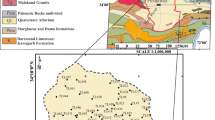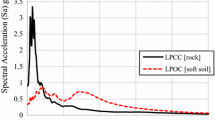Abstract
Ground motion response spectra (GMRS) at rock/soil sites in regions where earthquake ground motions have dominant contents at high frequencies of 10 Hz or more are evaluated and the effects of soil amplification on the GMRS are studied. The seismic hazard levels at the soil sites are estimated from soil amplification functions and hazard curves for rock outcrop motions. The soil amplification functions are obtained using modified earthquake ground motions which match the uniform hazard response spectra (UHRS) for rock outcrop motions with various mean annual frequencies of exceedance in order to consider the effects of earthquake ground motions consistently in a site response analysis. UHRS at soil sites are determined from the calculated seismic hazard curves. Subsequently, design factors, which will be applied to UHRS, and the corresponding GMRS are evaluated such that the seismic risk for the structures, systems, and components of nuclear facilities would be equal to a target seismic risk. It can be observed from example applications that the UHRS and GMRS at soil sites have peaks at the natural frequencies of the soil, where the soil responses are amplified. Amplification at soil sites depends on the frequency contents of rock outcrop motions.
Similar content being viewed by others
References
ASCE (2005) Seismic design criteria for structures, systems and components in nuclear facilities. ASCE/SEI 43-05, American Society of Civil Engineers, Reston, VA, USA
ASCE (2017) Seismic analysis of safety-related nuclear structures. ASCE/SEI 4-16, American Society of Civil Engineers, Reston, VA, USA
Bazzurro P, Cornell CA (2004a) Ground-motion amplification in nonlinear soil sites with uncertain properties. Bulletin of the Seismological Society of America 94:2090–2109, DOI: https://doi.org/10.1785/0120050186
Bazzurro P, Cornell CA (2004b) Nonlinear soil-site effects in probabilistic seismic-hazard analysis. Bulletin of the Seismological Society of America 94:2110–2123
EduPro Civil Systems, Inc. (2017) ProShake: Ground response analysis program version 2.0, User’s manual. EduPro Civil Systems, Inc., Sammamish, WA, USA
EPRI (1993) Guidelines for determining design basis ground motions. Technical Report EPRI TR-102293, Electric Power Research Institute, Palo Alto, CA, USA
Hancock J, Watson-Lamprey J, Abrahamson NA, Bommer JJ, Markatis A, McCoy E, Mendis R (2006) An improved method of matching response spectra of recorded earthquake ground motion using wavelets. Journal of Earthquake Engineering 10(S1):67–89, DOI: https://doi.org/10.1080/13632460609350629
Idriss IM, Seed HB (1967) Response of horizontal soil layers during earthquakes. Soil Mechanics and Bituminous Materials Research Laboratory, University of California, Berkeley, CA, USA
KAERI (2012) Probabilistic seismic hazard analysis procedure and application for nuclear power plant sites. KAERI/TR-4633/2012, Korea Atomic Energy Research Institute, Daejeon, Korea (in Korean)
Kaklamanos J, Baise LG, Thompson EM, Dorfmann L (2015) Comparison of 1D linear, equivalent-linear, and nonlinear site responsemodels at six KiK-net validation sites. Soil Dynamics and Earthquake Engineering 69:207–219, DOI: https://doi.org/10.1016/j.soildyn.2014.10.016
Kennedy RP (2011) Performance-goal based (risk informed) approach for establishing the SSE site specific response spectrum for future nuclear power plants. Nuclear Engineering and Design 241:648–656, DOI: https://doi.org/10.1016/j.nucengdes.2010.08.001
KEPCO & KHNP (2017) Evaluation of structure-soil-structure interaction (SSSI) effects. APR1400-E-S-NR-14005-NP, Rev. 2, Korea Electric Power Corporation & Korea Hydro & Nuclear Power Co., Ltd., Korea
Kramer SL (1996) Geotechnical earthquake engineering, 1st edition. Prentice Hall, Upper Saddle River, NJ, USA
Li B, Cai Z, Xie W, Pandey M (2018) Probabilistic seismic hazard analysis considering site-specific soil effects. Soil Dynamics and Earthquake Engineering 105:103–113, DOI: https://doi.org/10.1016/j.soildyn.2017.11.029
PEER Center (2020) PEER ground motion database. Pacific Earthquake Engineering Research (PEER) Center, Retrieved July 15, 2020, https://ngawest2.berkeley.edu/users/sign_in?unauthenticated=true
Pehlivan M, Rathje EM, Gilbert RB (2016) Factors influencing soil surface seismic hazard curves. Soil Dynamics and Earthquake Engineering 83:180–190, DOI: https://doi.org/10.1016/j.soildyn.2016.01.009
Schnabel PB, Lysmer J, Seed HB (1972) SHAKE: A computer program for earthquake ground response analysis for horizontally layered sites. Report No: EERC 72-12, Earthquake Engineering Research Center, University of California, Berkeley, CA, USA
Seismosoft (2018) SeismoMatch — A computer program for spectrum matching of earthquake records, Retrieved August 16, 2019, http://www.seismosoft.com
Song D, Che A, Zhu R, Ge X (2019) Natural frequency characteristics of rock masses containing a complex geological structure and their effects on the dynamic stability of slopes. Rock Mechanics and Rock Engineering 52:4457–4473, DOI: https://doi.org/10.1007/s00603-019-01885-7
Song D, Chen Z, Chao H, Ke Y, Nie W (2020) Numerical study on seismic response of a rock slope with discontinuities based on the time-frequency joint analysis method. Soil Dynamics and Earthquake Engineering 133, DOI: https://doi.org/10.1016/j.soildyn.2020.106112
USNRC (1973) Design response spectra for seismic design of nuclear power plants, Revision 1. Regulatory Guide 1.60, U.S. Nuclear Regulatory Commission, Washington DC, USA
USNRC (1997) Identification and characterization of seismic sources and determination of safe shutdown earthquake ground motion. Regulatory Guide 1.165, U.S. Nuclear Regulatory Commission, Washington DC, USA
USNRC (2001) Technical basis for revision of regulatory guidance on design ground motions: Hazard- and risk-consistent ground motion spectra guidelines. NUREG/CR-6728, U.S. Nuclear Regulatory Commission, Washington DC, USA
USNRC (2002) Technical basis for revision of regulatory guidance on design ground motions: Development of hazard- and risk-consistent seismic spectra for two sites. NUREG/CR-6769, U.S. Nuclear Regulatory Commission, Washington DC, USA
USNRC (2007a) A performance-based approach to define the site-specific earthquake ground motion. Regulatory Guide 1.208, U.S. Nuclear Regulatory Commission, Washington DC, USA
USNRC (2007b) Evaluation of the seismic design criteria in ASCE/SEI standard 43-05 for application to nuclear power plants. NUREG/CR-6926, U.S. Nuclear Regulatory Commission, Washington DC, USA
Zalachoris G, Rathje EM (2015) Evaluation of one-dimensional site response techniques using borehole arrays. Journal of Geotechnical and Geoenvironmental Engineering 141:04015053, DOI: https://doi.org/10.1061/(ASCE)GT.1943-5606.0001366
Acknowledgments
This work was supported by the National Research Foundation of Korea (NRF) grant funded by the Korean government (MSIT: Ministry of Science and ICT) (No.2017M2A8A401504221).
Author information
Authors and Affiliations
Corresponding author
Rights and permissions
About this article
Cite this article
Lee, J.H., Van Nguyen, H., Choi, IK. et al. Effects of Soil Amplification on Ground Motion Response Spectra with High-Frequency Contents at Generic Soil Sites for Nuclear Facilities in Korea. KSCE J Civ Eng 25, 2394–2410 (2021). https://doi.org/10.1007/s12205-021-0767-5
Received:
Revised:
Accepted:
Published:
Issue Date:
DOI: https://doi.org/10.1007/s12205-021-0767-5




